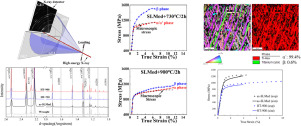当前位置:
X-MOL 学术
›
Acta Mater.
›
论文详情
Our official English website, www.x-mol.net, welcomes your
feedback! (Note: you will need to create a separate account there.)
Effect of heat treatment on the tensile behavior of selective laser melted Ti-6Al-4V by in situ X-ray characterization
Acta Materialia ( IF 8.3 ) Pub Date : 2020-05-01 , DOI: 10.1016/j.actamat.2020.03.003 Dingchang Zhang , Leyun Wang , Huan Zhang , Alireza Maldar , Gaoming Zhu , Wei Chen , Jun-Sang Park , Jie Wang , Xiaoqin Zeng
Acta Materialia ( IF 8.3 ) Pub Date : 2020-05-01 , DOI: 10.1016/j.actamat.2020.03.003 Dingchang Zhang , Leyun Wang , Huan Zhang , Alireza Maldar , Gaoming Zhu , Wei Chen , Jun-Sang Park , Jie Wang , Xiaoqin Zeng

|
Abstract Selective Laser Melted Ti-6Al-4V (as-SLMed) exhibits decreased yield strength, increased work hardening, and increased ductility after heat treatment at 730 °C (HT-730) or 900 °C (HT-900) for 2 h. To understand the change of mechanical properties, in situ high energy X-ray diffraction (HEXRD) is used to examine the phase composition, load partitioning, slip system activity, and dislocation density evolution in all three specimens. The as-SLMed specimen is dominated by martensitic α΄. After heat treatment, α΄ partly or fully decomposes into α+β, reducing the yield strength. In HT-730, β precipitates with confined size show much higher lattice strain than the α΄/α matrix during deformation; in HT-900, the lattice strain difference is mostly eliminated. This is a key reason for the increased ductility in HT-900. From the anisotropic lattice strain development, basal slip is identified as the easiest slip system in α΄/α. Using an elasto-plastic self-consistent (EPSC) model, the critical resolved shear stress ratio between prismatic slip and basal slip (CRSSprism/CRSSbasal) is estimated to be 1.31 and 1.16 in the as-SLMed and the HT-900 specimens, respectively. The α phase in HT-900 is able to activate multiple slip systems and accumulate more dislocations during plastic deformation. This explains why HT-900 has better ductility and higher work hardening rate than the other two specimens.
中文翻译:

通过原位 X 射线表征热处理对选择性激光熔化 Ti-6Al-4V 拉伸行为的影响
摘要 选择性激光熔化 Ti-6Al-4V (as-SLMed) 在 730 °C (HT-730) 或 900 °C (HT-900) 热处理 2 小时后屈服强度降低,加工硬化增加,延展性增加. 为了了解机械性能的变化,原位高能 X 射线衍射 (HEXRD) 用于检查所有三个试样的相组成、载荷分配、滑移系统活动和位错密度演化。SLMed 试样主要是马氏体α΄。热处理后,α΄部分或全部分解成α+β,降低屈服强度。在 HT-730 中,尺寸受限的 β 析出物在变形过程中表现出比 α΄/α 基体高得多的晶格应变;在HT-900中,晶格应变差大部分被消除。这是 HT-900 延展性增加的一个关键原因。从各向异性晶格应变发展来看,基底滑移被认为是 α΄/α 中最容易的滑移系统。使用弹塑性自洽 (EPSC) 模型,估计在 as-SLMed 和 HT-900 试样中棱柱滑移和基底滑移之间的临界解析剪应力比 (CRSSprism/CRSSbasal) 分别为 1.31 和 1.16 . HT-900 中的 α 相能够激活多个滑移系统并在塑性变形过程中积累更多位错。这就解释了为什么 HT-900 比其他两种试样具有更好的延展性和更高的加工硬化率。分别在 as-SLMed 和 HT-900 试样中为 16。HT-900 中的 α 相能够激活多个滑移系统并在塑性变形过程中积累更多位错。这就解释了为什么 HT-900 比其他两种试样具有更好的延展性和更高的加工硬化率。分别在 as-SLMed 和 HT-900 试样中为 16。HT-900 中的 α 相能够激活多个滑移系统并在塑性变形过程中积累更多位错。这就解释了为什么 HT-900 比其他两种试样具有更好的延展性和更高的加工硬化率。
更新日期:2020-05-01
中文翻译:

通过原位 X 射线表征热处理对选择性激光熔化 Ti-6Al-4V 拉伸行为的影响
摘要 选择性激光熔化 Ti-6Al-4V (as-SLMed) 在 730 °C (HT-730) 或 900 °C (HT-900) 热处理 2 小时后屈服强度降低,加工硬化增加,延展性增加. 为了了解机械性能的变化,原位高能 X 射线衍射 (HEXRD) 用于检查所有三个试样的相组成、载荷分配、滑移系统活动和位错密度演化。SLMed 试样主要是马氏体α΄。热处理后,α΄部分或全部分解成α+β,降低屈服强度。在 HT-730 中,尺寸受限的 β 析出物在变形过程中表现出比 α΄/α 基体高得多的晶格应变;在HT-900中,晶格应变差大部分被消除。这是 HT-900 延展性增加的一个关键原因。从各向异性晶格应变发展来看,基底滑移被认为是 α΄/α 中最容易的滑移系统。使用弹塑性自洽 (EPSC) 模型,估计在 as-SLMed 和 HT-900 试样中棱柱滑移和基底滑移之间的临界解析剪应力比 (CRSSprism/CRSSbasal) 分别为 1.31 和 1.16 . HT-900 中的 α 相能够激活多个滑移系统并在塑性变形过程中积累更多位错。这就解释了为什么 HT-900 比其他两种试样具有更好的延展性和更高的加工硬化率。分别在 as-SLMed 和 HT-900 试样中为 16。HT-900 中的 α 相能够激活多个滑移系统并在塑性变形过程中积累更多位错。这就解释了为什么 HT-900 比其他两种试样具有更好的延展性和更高的加工硬化率。分别在 as-SLMed 和 HT-900 试样中为 16。HT-900 中的 α 相能够激活多个滑移系统并在塑性变形过程中积累更多位错。这就解释了为什么 HT-900 比其他两种试样具有更好的延展性和更高的加工硬化率。











































 京公网安备 11010802027423号
京公网安备 11010802027423号